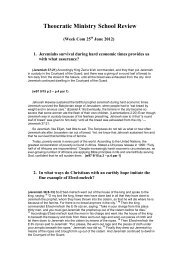1964 Awake! - Theocratic Collector.com
1964 Awake! - Theocratic Collector.com
1964 Awake! - Theocratic Collector.com
Create successful ePaper yourself
Turn your PDF publications into a flip-book with our unique Google optimized e-Paper software.
experts at warming their city. Should the<br />
temperature of the hive fall, the bees stoke<br />
their bodies with honey, which, due to<br />
their body's high metabolism, is quickly<br />
converted to heat. Thus, the temperature<br />
of the hive is raised. In the brood area,<br />
bees maintain a temperature that is constant<br />
within one and a half degrees, even<br />
though the outside temperatW'e may vary<br />
thirty to forty degrees.<br />
A more serious problem arises in the<br />
winter. How do bees survive when the<br />
temperature falls many degrees below zero?<br />
They are unable to hibernate or migrate,<br />
so ingeniously they stoke up a furnace<br />
by which to keep warm. But such a<br />
furnace you have never seen before!<br />
Many bees form a closely packed shell to<br />
confine the heat within. Bees at the center<br />
of this insulating shell keep in constant<br />
motion, generating heat. When the temperature<br />
falis, the insulating shell shrinks<br />
and the dancers within move faster; but<br />
when the temperature rises, the shell of<br />
bees expands and the movements of those<br />
at the center slows down. By this means<br />
the temperature is regulated. But how do<br />
those bees clinging on the outside avoid<br />
succumbing to the cold'? Careful observation<br />
reveals the answer.<br />
Those bees <strong>com</strong>posing the insulating<br />
shell are noted to be continually changing<br />
places with the dancers on the inside.<br />
There is a persistent floW from the center<br />
to the outer edges and back again. In this<br />
way the bees alternately be<strong>com</strong>e heated<br />
by activity, and cooled during rest periods.<br />
Honey, of course, is the fuel that runs this<br />
amazing furnace. Yes, the foresighted bees<br />
have stocked up sufficient supplies to last<br />
the winter.<br />
Engineering Wonders<br />
Men take pride in their engineering<br />
feats, and, indeed, some of them are wonderful,<br />
but even in this field humans have<br />
SEPTEMBER fre, <strong>1964</strong><br />
learned from the lowly bee. Although possessing<br />
no college degree in structural engineering,<br />
two-week-old worker bees construct<br />
honey<strong>com</strong>bs that are masterpieces<br />
of structural design. For centuries men,<br />
have been intrigued by them, but it is only<br />
in recent years that close scientific observation<br />
has shown how truly marvelous<br />
they are.<br />
The construction material is of the bees'<br />
O\V!l making. Young workers gorge themselves<br />
on honey, and, after several hours,<br />
wax begins to appear as thin flakes on<br />
their abdomen. Transferring it to the<br />
mouth, the bees chew the wax thoroughly,<br />
mixing it with a frothy liquid and microscopic<br />
bubbles of air. Then a miracle of<br />
engineering takes place. The bees, working<br />
in cooperation with one another, shape<br />
this plastic material into perfect six-sided<br />
honey<strong>com</strong>b cells. Amazingly, the cells are<br />
formed with such unvarying accuracy that<br />
at one time French scientist Rene de<br />
Reaumur proposed making them a standard<br />
of measure.<br />
Equally amazing, however, is the choice<br />
of the six-sided design. It provides the<br />
maximum strength, the greatest storage<br />
space and, at the same time, fits the shape<br />
of the bee. It is the one and only ideal<br />
shape for the honey<strong>com</strong>b! In order to obtain<br />
maximum strength for the least<br />
weight men have also employed this hexagonal<br />
design in their engineering projects.<br />
Field Work<br />
After about three weeks of inside chores<br />
the worker bees graduate to gathering pollen<br />
and nectar from the fields. Although<br />
they literally work themselves to death in<br />
about a month, this industriousness during<br />
the summer assures survival of the bee<br />
colony in the winter. In fact, bees gather<br />
such a surplus that in the United States<br />
alone some 250,000,000 potUlds of honey<br />
are harvested each year! When it is con-<br />
23




